Introduction
Relationships Australia has previously explored different aspects of community participation in the monthly online survey. This includes levels of participation in particular activities that are associated with positive wellbeing, and relationships between participation and people’s perception of their local neighbourhood, including whether they feel it is safe and has good local facilities.
Where individuals participate in their community through volunteering, there is a growing body of research that indicates individual health and social benefits for both volunteers and the community. In one US study, for example, volunteers were found to have lower mortality rates, greater functional ability, and lower rates of depression later in life than those who do not volunteer. These positive effects are most significant for older volunteers and authors have postulated that this could be because volunteering provides them with physical and social activity and a sense of purpose at a time when their social roles are changing.
In May 2017, Relationships Australia’s monthly online survey asked website visitors to report on their level of volunteering and perceptions of the benefits of volunteering to both recipients and volunteers.
Previous research finds that…
- In a South Australian study in 2016, the most common way the formal volunteers surveyed became involved in volunteering was: ‘involvement with a club/association’ (21%); followed by ‘someone asked me’ (19%); a ‘family history/culture of volunteering’ (15%); and ‘through my children’s school’ (12%).
- Reasons cited for volunteering include personal satisfaction, to feel part of the community, friendship and increased self-esteem.
- Perceived benefits to recipients of volunteering included: ‘people get help they wouldn’t otherwise get’ (24%); ‘many community projects/programs would cease to exist’ (21%); and ‘many organisations would cease to exist’ (20%).
Results
Just under 1,200 people responded to the Relationships Australia online survey in May 2017. More than three-quarters of survey respondents identified as female, with more females than males responding in every age group (see Figure 1 below). Eighty-four per cent of survey respondents were aged between 20‑59 years, and more than half of the respondents comprised women aged between 30-49 years (inclusive).
As for previous surveys, the demographic profile of survey respondents remains consistent with our experience of the groups of people that would be accessing the Relationships Australia website.
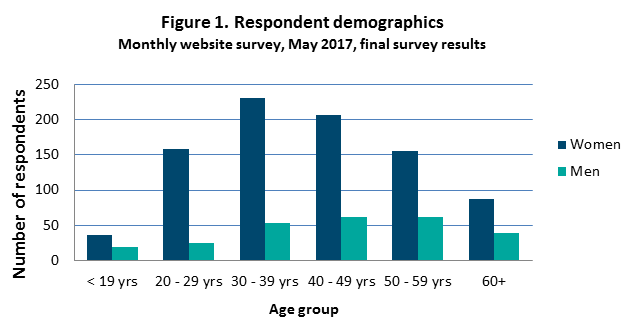
Both male and female survey respondents reported that they thought volunteering provided a great deal of benefit to the community. Women (77%) were more likely than men (70%) to report that the community benefits a great deal from volunteering, while only four per cent of men and women reported that volunteering provided little or no benefit to the community. The perceived benefits of volunteering most commonly reported included: ‘increased opportunities for social connection’; ‘have access to services that would otherwise be expensive or unavailable’; ‘improved general happiness’ and ‘improved mental health’ (figure 2).
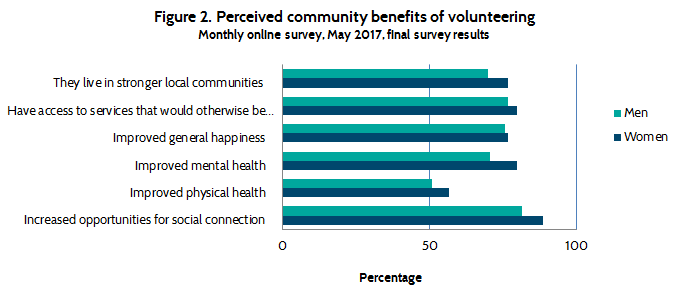
Ratings of the personal benefits of volunteering were lower than levels of perceived benefits reported for recipients of volunteering.
Women (63%) were more likely than men (47%) to report that volunteers received a ‘great deal’ of personal benefit from volunteering, while men (44%) were more likely than women (29%) to report that volunteers received a ‘fair bit’ of personal benefit from volunteering. Ten per cent of survey respondents reported that there was little or no personal benefit from volunteering.
Perceived personal benefits of volunteering most commonly included: ‘greater opportunity for social connection’; ‘opportunities for skill development’; and ‘improved general happiness’.
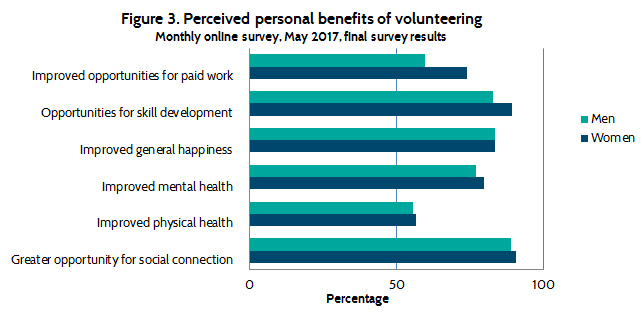
The most commonly reported sources of volunteering opportunities included word of mouth, volunteering support organisations, community websites and traditional or social media (figure 4). Women (29%) were more likely than men (22%) to report community websites as a source of volunteering opportunities, while men were more likely to report the other three most common sources of volunteering opportunities.
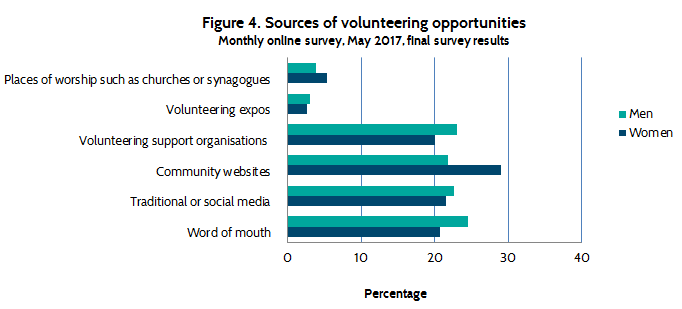
Overall, female survey respondents (65%) were more likely to volunteer than males (61%). Of those people who reported that they currently volunteer, men (12%) were more likely than women (6%) to report longer hours of volunteering.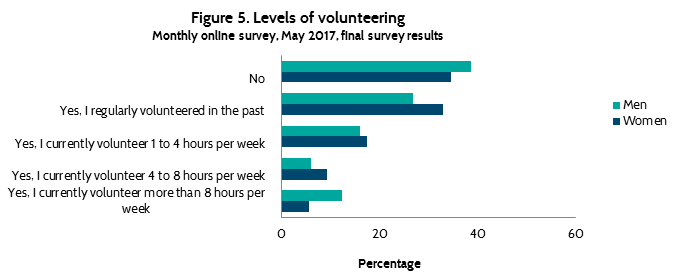
References
Anik, L, Aknin, L, Norton, M, & Dunn, E. (2009). The Benefits (and Costs) of Self-Interested Charitable Behaviour, Working paper 10/012, available at http://www.hbs.edu/faculty/Publication%20Files/10-012.pdf
Australian Bureau of Statistics (2008). Australian Social Trends, cat. no. 4102.0
Berry, H.L. & Shipley, M. (2009). Longing to belong: personal social capital and psychological distress in an Australian coastal region. Social Policy Research Paper No. 39. Canberra.
South Australian Government, Office of volunteering (2016), Volunteering in South Australia available at http://www.ofv.sa.gov.au/publications-and-research/volunteer-survey
Acknowledgement
Relationships Australia would like to acknowledge Volunteering and Contact ACT for their assistance in drafting the questions for the May 2017 monthly survey.
